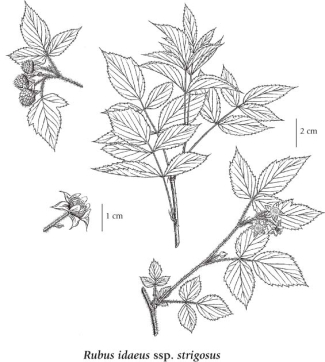Rubus idaeus subsp. strigosus L. (Michx.) Focke
red raspberry (grayleaf red raspberry)
Rosaceae (Rose family)
Introduction to Vascular Plants
red raspberry (grayleaf red raspberry)
Rosaceae (Rose family)
Introduction to Vascular Plants
Map
Distribution of Rubus idaeus subsp. strigosus
Click here to view the full interactive map and legend
Species Information
General:
Medium shrub, 0.5-2 m tall, perennial with biennial stems (canes); stems erect to ascending, almost unarmed to prickly and bristly, often glandular-hairy, sometimes smooth and glaucous beneath the prickles; bark yellow to cinnamon-brown, shredding; similar to cultivated raspberry.
Leaves:
Alternate, deciduous, pinnately compound, 5-20 cm long; leaflets 3 to 5 on first-year canes, mostly 3 on flowering canes, egg-shaped to broadly lanceolate, 3-10 cm long, double-saw-toothed and sharply long-pointed at the tip, greenish and smooth to sparsely hairy above, paler and greyish-woolly to nearly smooth beneath, the veins and leaf-stalks often glandular-prickly; stipules linear-awl-shaped, 4-10 mm long.
Flowers:
Inflorescence of 1 to 4 stalked flowers in small, open, nodding, axillary or terminal clusters, the stalks often bristly-glandular; corollas white, the petals 5, erect, oblong-spoon-shaped, 4-7 mm long; calyces hairy to glandular-bristly, 5-lobed, the lobes lanceolate, bent back, 4-8 (12) mm long; ovaries superior; stamens 75-100.
Fruits:
Drupelets, finely and thinly woolly, weakly coherent in a red egg-shaped cluster that falls intact from the dry receptacle (a raspberry), the berries 1-1.2 cm wide.
Illustration

If more than one illustration is available for a species (e.g., separate illustrations were provided for two subspecies) then links to the separate images will be provided below. Note that individual subspecies or varietal illustrations are not always available.
Illustration Source: The Illustrated Flora of British Columbia
USDA Species Characteristics
Flower Colour:
White
Blooming Period:
Late Summer
Fruit/Seed characteristics:
Colour: Red
Present from Summer to Fall
Source: The USDA
Ecology
Ecological Framework for Rubus idaeus ssp. strigosus
The table below shows the species-specific information calculated from
original data (BEC database) provided by the BC Ministry of Forests and Range.
(Updated August, 2013)
The table below shows the species-specific information calculated from
original data (BEC database) provided by the BC Ministry of Forests and Range.
(Updated August, 2013)
| Site Information |
Value / Class |
||
|
Avg |
Min |
Max |
|
| Elevation
(metres) |
758 | 436 | 1083 |
| Slope
Gradient (%) |
5 | 2 | 10 |
|
Aspect (degrees) |
166 | 87 | 235 |
| Soil
Moisture Regime (SMR) [0 - very xeric; 4 - mesic; 8 - hydric] |
3 | 3 | 3 |
| Modal
Nutrient Regime
Class |
C | ||
| #
of field plots species was recorded in: |
3 | ||
| Modal
BEC Zone Class |
ICH | ||
|
All BEC Zones (# of stations/zone) species was recorded in |
ICH(2), IDF(1) | ||
|
Source:
Klinkenberg 2013
|
|||
Habitat and Range
Mesic to moist thickets, rocky slopes, clearings, burns, old fields and open forests in the lowland and montane zones; common throughout BC mostly in and east of the Coast-Cascade Mountains; E to NF and S to CA, N MX and NC.Status Information
Synonyms
Synonyms and Alternate Names:
Rubus carolinianus Rydb.
Rubus idaeus subsp. melanolasius (Dieck) Focke
Rubus idaeus subsp. sachalinensis (Levl.) Focke
Rubus idaeus var. aculeatissimus Regel & Tiling
Rubus idaeus var. canadensis Richardson
Rubus idaeus var. gracilipes M.E. Jones
Rubus idaeus var. melanolasius (Dieck) R.J. Davis
Rubus idaeus var. melanotrachys (Focke) Fernald
Rubus idaeus var. strigosus (Michx.) Maxim.
Rubus melanolasius Dieck
Rubus neglectus Peck
Rubus strigosus Michx.
Rubus strigosus var. acalyphaceus (Greene) L.H. Bailey
Rubus strigosus var. arizonicus (Greene) Kearney & Peebles
Rubus strigosus var. canadensis (Richardson) House